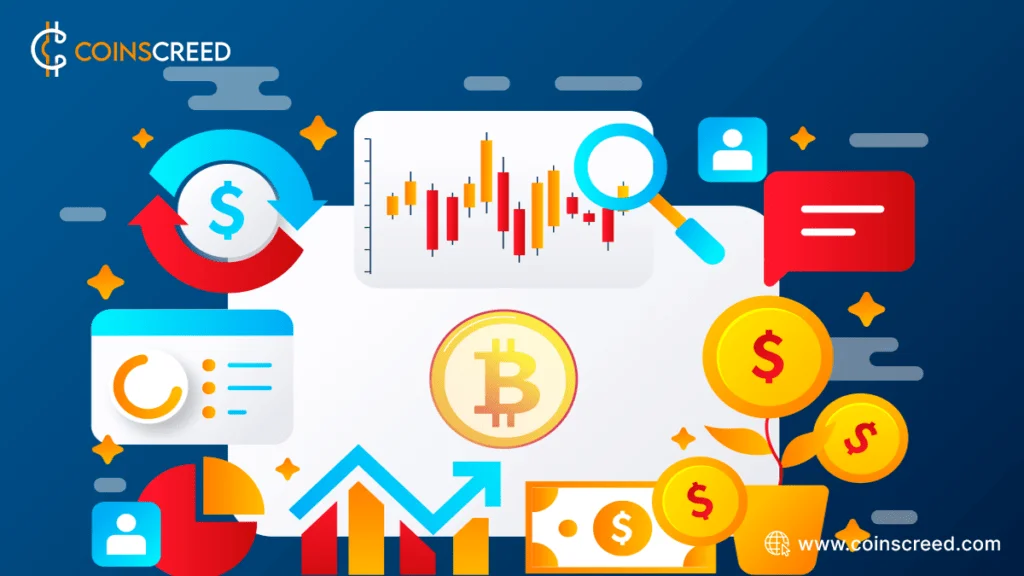Cryptocurrency trading has become a popular investment option for many people worldwide. While the traditional way of trading cryptocurrencies involves buying and selling them on exchanges, there are other ways to invest in these digital assets. Cryptocurrency derivatives trading is one such way, where investors can use contracts that derive their value from cryptocurrencies.
In this beginner’s guide to cryptocurrency derivatives trading, we’ll explore three types of derivatives trading: futures, options, and swaps.

What Are Cryptocurrency Derivatives?
Before diving into futures, options, and swaps, it’s important to understand what cryptocurrency derivatives are. Cryptocurrency derivatives are contracts that enable investors to predict the future price movements of cryptocurrencies.
Derivatives trading is not new to the financial markets. It has existed for a long time, and its popularity has grown massively. The emergence of cryptocurrency derivatives trading has made it possible for investors to trade these digital assets in a more structured and regulated manner.
Futures Trading
A futures contract is an agreement between two parties to buy or sell a specific asset at a predetermined price and date in the future. In cryptocurrency futures trading, the underlying asset is a cryptocurrency. Like other assets, you can buy and sell futures contracts on exchanges.
The investor can choose to go long or short when trading cryptocurrency futures; going long means that the investor expects the crypto currency’s price to rise in the future while going short means that the investor expects the price to fall.
Pros Of Futures Trading
Some of the advantages of Futures Trading are:
- High liquidity
- Leverage
- Hedging
- Transparency
>High liquidity
Futures markets are highly liquid, meaning many buyers and sellers are in the market. It can make it easier to enter and exit trades quickly and at a fair price.
>Leverage
Futures contracts typically require less capital than buying the underlying asset outright. It can allow traders to control a more prominent position with less capital.
>Hedging
Futures trading can be used as a hedging tool to protect against price fluctuations in the underlying asset. For example, farmers could sell futures contracts for their crops to lock in a specific price and protect against price drops.
>Transparency
Futures markets are regulated and transparent, meaning prices and market information are readily available to traders.
Cons of Futures Trading
- High risk
- Margin calls
- Complex
- Limited flexibility
>High risk
Futures trading is a high-risk investment strategy that can result in significant losses if not managed properly. Traders should carefully consider their risk tolerance before entering the market.
>Margin calls
Futures contracts require traders to maintain a certain margin in their accounts. If the market moves against a trader, they may be required to deposit more funds into their account to meet margin requirements.
>Complex
Futures trading can be complex and require a thorough understanding of the market and trading strategies. Beginners should start with a small investment and gradually increase their knowledge and experience.
>Limited flexibility
Futures contracts have fixed expiration dates and contract specifications, which may only be suitable for some trading strategies.

Options Trading
Options trading is another type of cryptocurrency derivatives trading. An options contract gives the holder the right, but not the obligation, to buy or sell the underlying asset at a specific price and date. The buyer of an options contract pays a premium for this right.
Types Of Options
There are two types of options:
- Call options
- Put options
>Call Options
A call option gives the holder the right to buy the underlying asset at a specific price
>Put options
A put option gives the holder the right to sell the underlying asset at a specific price.
Pros Of Options Trading
- Limited risk
- Flexibility
- Leverage
- Hedging
>Limited risk
Options trading allows traders to limit risk by purchasing options contracts with a predetermined maximum loss amount.
>Flexibility
Options trading provides traders with various strategies, including buying and selling options, that can be used in different market conditions.
>Leverage
Options trading can allow traders to control a more prominent position with less capital.
>Hedging
Options trading can be used as a hedging tool to protect against price fluctuations in the underlying asset.
Cons Of Options Trading
- Complex
- Time decay
- Limited profit potential
- Higher fees
>Complex
Options trading can be complex and require a thorough understanding of the market and trading strategies.
>Time decay
Options contracts have expiration dates, and the value of an option decreases as it gets closer to the expiration date.
>Limited profit potential
Options trading can have limited profit potential, especially when buying options contracts, which can expire worthless if the market doesn’t move in the expected direction.
>Higher fees
Options trading can have higher fees than other trading types, such as stocks or futures.
Swaps Trading
Swaps trading involves two parties exchanging cash flows based on an underlying asset’s price. In cryptocurrency swaps trading, the underlying asset is a cryptocurrency. The cash flows can be fixed or floating, depending on the contract terms.
Swaps trading can be used to hedge against price fluctuations or speculate on future price movements. It can also be used to exchange one cryptocurrency for another. Swaps are customized contracts that are not traded on exchanges but are typically traded over the counter.
Pros Of Swaps Trading
- Customization
- Risk management
- Flexibility
- No upfront payment
>Customization
Swaps trading allows for customized contracts that can be tailored to meet the parties’ specific needs.
>Risk management
Swaps trading can be a risk management tool to hedge against various financial risks, such as interest rate or currency risk.
>Flexibility
Swaps trading provides traders with various strategies, including fixed-for-floating swaps, currency swaps, and commodity swaps.
>No upfront payment
Swaps trading doesn’t require any upfront payment, making it more accessible to traders with limited capital.
Cons Of Swaps Trading
- Counterparty risk
- Lack of transparency
- Regulatory risks
- Complexity
>Counterparty risk
Swaps trading involves counterparty risk, meaning that one party may default on their obligation to make payments or deliver assets, which can lead to significant losses for the other party.
>Lack of transparency
Swaps trading can be less transparent than other types of trading, as it often occurs in private over-the-counter markets.
>Regulatory risks
Swaps trading is subject to regulations and may be affected by changes in regulatory requirements or government policies.
>Complexity
Swaps trading can be complex and require a thorough understanding of the market and trading strategies.
Comparison of Futures, Options, and Swaps Trading
Futures, options, and swaps trading have some similarities and differences. One of the similarities is that all three types of trading involve derivatives contracts whose value is derived from cryptocurrencies. However, the contracts differ in structure, how they are traded, and the risks and rewards associated with them.
Tips for Beginners
If you’re new to cryptocurrency derivatives trading, it’s essential to take a cautious approach. Here are some tips for beginners:
- Do your research
- Start small
- Use risk management strategies
- Stay informed
- Choose a reputable exchange
Do your research
Before getting started, understand how cryptocurrency derivatives trading works, the risks involved, and the types of contracts available. This will help you make informed decisions when trading.
Start small
It’s a good idea to start with a small investment and gradually increase it as you gain more experience and confidence in your trading abilities.
Use risk management strategies
Derivatives trading can be risky, so using risk management strategies to limit potential losses is essential. For example, setting stop-loss orders can help minimize losses if the market moves against you.
Stay informed
Keep up-to-date with the latest news and developments in the cryptocurrency market. This can help you make informed trading decisions and adjust your strategy.
Choose a reputable exchange
When trading cryptocurrency derivatives, using a reputable, regulated exchange with a good reputation is essential. This can help ensure that your funds are safe and that you are trading on a fair and transparent platform.
Conclusion
Cryptocurrency derivatives trading offers investors a way to speculate on the future price movements of cryptocurrencies. Futures, options, and swaps trading are three types of derivatives trading that can be used to trade cryptocurrencies. Each type of trading has its benefits and risks, and investors should consider their investment goals and risk tolerance when choosing which type of trading to use.
While cryptocurrency derivatives trading can be risky, it can also be profitable for those who cautiously approach it and use sound risk management strategies. By following the tips outlined in this guide, beginners can start trading cryptocurrency derivatives confidently and increase their chances of success in the market.
